What is Banner Blindness: Its Psychology and How To Avoid It

Table of Contents
- What is Banner Blindness?
- Where Did Banner Advertising Come From?
- How did the Banner Blindness Phenomenon Come About?
- Why are Advertising Banners Increasingly Ignored by the User Community?
- Banner Blindness as an Expression of a New Form of Internet Usage
- Five Factors Contributing To Banner Blindness
- How do Advertisers Deal with Banner Blindness?
- 11 Ways To Fight Banner Blindness
- Key Takeaways
- Conclusion
- FAQs
When was the last time a banner advertisement excited you? Can’t really recall, isn’t it? But, there are hundreds of thousands of banner advertisements laid out on the websites. And only a handful of them makes the correct impression.
The main reason behind this is banner blindness, wherein users are entirely blind to the ads displayed on the banner. In this detailed article, we will look at banner blindness and how to overcome it. So continue reading below and get enlightened!
What is Banner Blindness?
Banner blindness is part of web-user behavior and describes the tendency of website visitors to ignore page elements that they perceive to be ads. Researchers measure banner blindness to understand whether or not certain types of banner ads on websites are effective.
Modern research has shown that most Internet surfers have some banner blindness in many ways. Repetitive studies show that people are much more likely to focus on the core text and headings of the website than on banner ads at the top of the page. Banner blindness started early in the life of the Internet when more and more people learned that banner ads were often of little value on the website. It’s also easy to ignore these ads once you’ve been conditioned to do so because they’re usually on the periphery of the page.
Some studies show that up to 86 percent of readers don’t even focus on banner ads. To combat banner blindness, advertisers have used creative tricks to make banner ads look like computer system messages. This increases the effectiveness of advertising banners but is still considered entirely out of date and is relatively ineffective in online advertising.
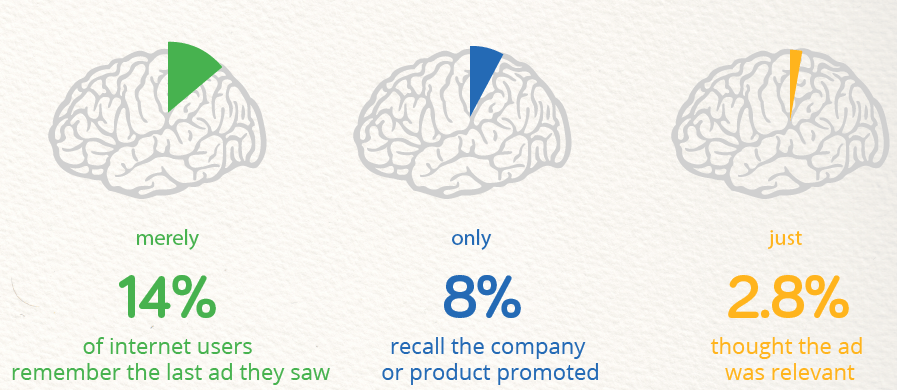
Where Did Banner Advertising Come From?
The term banner blindness was used for the first time in 1998 when two scientists proved in a series of tests that users consciously or unconsciously ignore banner advertising. To prove this, the test subjects were given the task of looking for information on a specific topic on a website. For this purpose, the test groups had the opportunity to click on a further link in the form of a banner and internal links.
Another result of the study was that the position of banners and their design does not necessarily contribute to the success of the clicks. Many advertising professionals were already aware that advertising banners were perceived differently. But with the study by Lane and Benway, the banner blindness phenomenon was given a scientifically well-founded meaning for the first time.
The discussion about the phenomenon of banner blindness continues to this day. Different research approaches also consider the user’s intentions when surfing the web. According to some researchers, a distinction must be made between users specifically looking for information and users on the Internet to pass the time. According to tests, the latter are more willing to take in information via banners than information seekers who are already focused on their topic at the start of the Internet search and therefore ignore additional details, comparable to skimming while reading.

How did the Banner Blindness Phenomenon Come About?
From the very beginning, the Internet was used very often for advertising. The first advertising banner came from the AT&T corporation in 1994 with an image size of 468 x 60 pixels. The ad had the following text: “Have you ever clicked your mouse right here? You will.” The click-through rate was an incredible 44%! Today, a CTR of 0.05% is considered good. The previously unknown and unachieved high reach and standard designs were very lucrative for advertisers. So you switched advertising banners on various websites and shops.
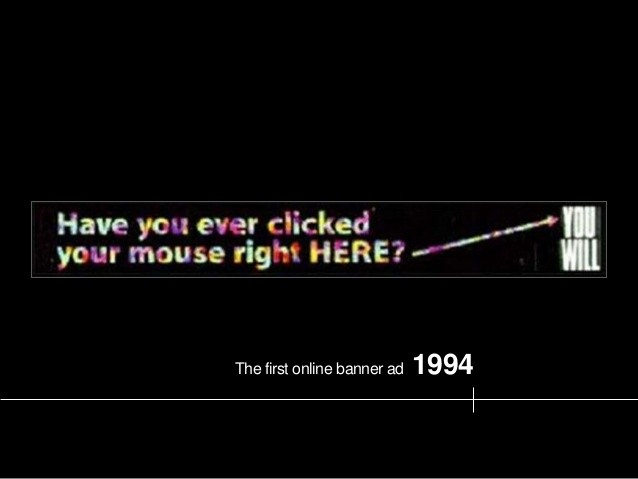
You can still see banner advertisements in many places on websites today. These usually have a standard size and are placed in specific locations on the surface of homepages. At the beginning of the phenomenon, advertising banners are deliberately ignored and not noticed. This is the preliminary stage to banner blindness, the so-called banner burnout. After the user has seen some websites with standardized advertisements and consciously not noticed them, the human brain unconsciously ignores all advertisements or even content that looks like an advertisement.
In a creeping process, you get used to it. This means that even information texts from users are ignored if they remind one of an advertisement and are placed, for example, in a place on the website where normally only advertising banners of a corresponding size are positioned. We are already in the progressive stage of banner blindness when we unconsciously ignore banners.
Why are Advertising Banners Increasingly Ignored by the User Community?
Despite their negative image, we still encounter many advertising banners on the Internet today: social media, forums, advice pages, and many other platforms. They are often designed in bright colors and large fonts or with changing sliders.
In the meantime, however, users have become much more enlightened and associate relevant elements such as large images or eye-catching banners with advertising – i.e., the content they have not explicitly looked for.
The result: advertising and information banners are ignored. The users thus develop blindness for advertising banners (banner blindness). Instead, preference is given to clicking on text links – even if they lead to the same destination.
Banner Blindness as an Expression of a New Form of Internet Usage
User behavior on the Internet has changed drastically over the past few years. Today the motto is: get to the desired destination as quickly and with as little effort as possible. In most cases (advertising), banners do not lead there.
The logical consequence: They are simply hidden. This effect is reinforced by increasing caution on the Internet, triggered by banners that bombard users with advertising, lead to fake competition, or infect computers with malware. This circumstance continues to fuel the lousy reputation of banner advertising.
Five Factors Contributing to Banner Blindness
Several factors contribute to banner blindness, and some of the important ones are discussed under the following headings.
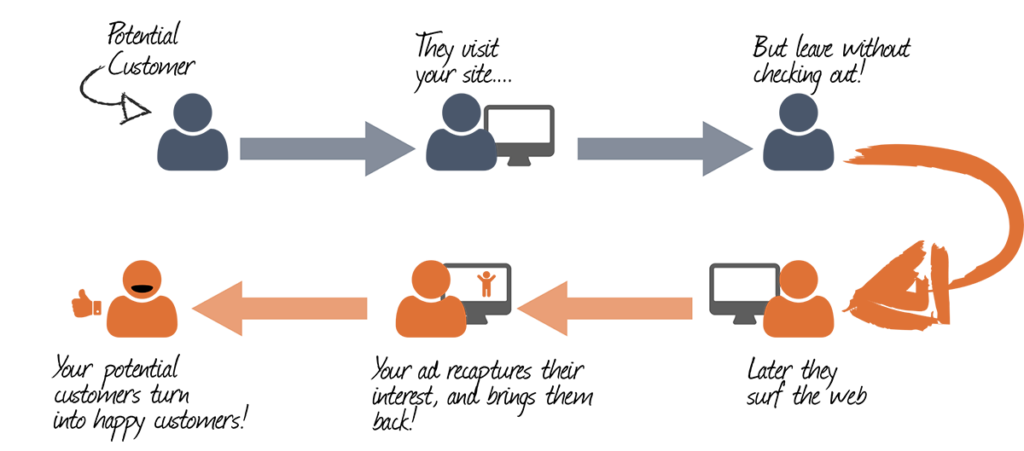
1. Location
The banner’s location has an unmistakable impact on users’ browsing behavior. And like several user behaviors on the Internet, users prefer skipping the banner part of the website. It is so because they have visited umpteen websites that display banner advertisements.
2. Ad clutter
One of the most common reasons for banner blindness is the different ads popping out of a website. If the web page offers numerous text ads, popup ads, and banner ads, users tend to lose their focus and get annoying. Hence, users ignore the ads and focus on the web content.
3. Visuals and ad style
The general look of advertisements, especially poorly designed ones, often irritates visitors. However, it is essential to note that ignoring advertisements is learned. So, most users have a subconscious and conscious knowledge about how the ads look, and they simply try to avoid them. As a result, many users skip or ignore the ad at lightning speed, whether the ad is proper.
4. Perceived usefulness
The main focus of the advertisement is to focus on the right audience. If the ads are displayed to the wrong audience, they simply skip and ignore it. Ads that lack relevance to the users are often perceived to be boring and annoying. One should never forget that the responsive behavior of the users is directly related to their personalization.
5. Improper ad placement
Advertisements that are not appropriately placed are poisonous. These ads often let the users ignore the significant elements of the site content. Usually, the content is posted on the same screen and is often misunderstood as ads and is skipped by the users.
How do Advertisers Deal with Banner Blindness?
Banner blindness is not limited to advertising banners. In most cases, the user ultimately decides which elements are perceived. As a result, content that is not advertising is also hidden – mainly because it is designed unfavorably.
Advertisers and web developers are now faced with the challenge of finding a solution to this problem. The first thing to do here is to avoid suspicious “eye-catchers.” The strategic placement of the content also plays an important role.
11 Ways to Fight Banner Blindness
Is banner blindness killing the advertisement industry? And most important, what can be done to overcome banner blindness? These are some of the different ways to combat banner blindness.
1. Check the ad’s placement
Try placing the ads in unconventional places on the site. It can be above the fold, in the text, or just after it. The ad can be within the blog, like between two different posts. Always remember to make the ad interactive and beautiful with an element of surprise. To increase the CTR (click-through rate), try experimenting with various elements that attract users’ attention, like videos and social media buttons.
2. Use relevant content
Advertisers must understand the audience’s needs and offer a pertinent solution to them. But unfortunately, irrelevant content is often ignored and skipped by the users. So first, identify the requirements of the user and deliver ads accordingly.
The content should make good use of primary and secondary keywords. Use cookies for creating relevant ads and select the correct ad network. When the website offers targeted, delightful, relevant, and valuable advertisements, the visitors will respond positively.
3. Use non-standard colors, sizes, and ad formats
Often seeing the same thing repeatedly can get monotonous. This will surely curtail the overall performance of the ads. Therefore, while creating the ad space, select memorable and non-traditional locations to improve the user recall and avoid being overlooked.
Try creating the banner as a part of the webpage. Also, use animated banner ads like 3D designs and motion effects to increase user interaction. Using brand personality and unusual colors on the website will improve user engagement.
4. Mobile optimization
These days, websites must be mobile optimized to keep up with the younger smartphone audience. So make sure that the site is mobile-friendly. If not, try testing the site and see how it looks on the smaller screen.
Once this is done, decrease the clutter. People who minimize the clutter on their web pages will undoubtedly attract advertisers who would pay for the uncluttered and premium space.
5. Catchy CTA
The message in the advertisement matters a lot. The answer to the question “What is the most important element to combat banner blindness” would be a clear message to the audience. While writing the ad, ask this question – “what is the goal you wish to achieve with this ad?” Then create a catchy CTA that appropriately delivers the message to the users. A successful CTA prompts users to take the desired action.
6. Separating ads from content
Avoid mixing content with the advertisements in the same visual action. Failure to do so would prompt the users to ignore the ads and the content. In addition, shapes, objects, and items close to each other are often presumed to be a part of the group. So make sure that the ads and the content section are in separate blocks.
7. Implementing native ads
Native ads are those advertisements that are implemented within the online feed content. Native ads can be graphic ads in mobile apps, text ads in social media feeds, or short video ads shown between different episodes. A study shows that native ads have a consumption of 47% in comparison to regular banner ads. Therefore, implementing native ads can offer better viewability and fight banner blindness.
8. Avoid using an old ad look
Make sure that the content doesn’t blatantly look like an advertisement. Go through the top websites and see the colors used on the web pages. Try to incorporate the same design and color–like the green Facebook banner ad. In that way, the ad would not be disruptive.
9. Use 3D photo ads
Contrary to conventional banner advertisements, 3D photo ads are pretty catchy and attract the users’ immediate attention. With the 3D photo ads, users can interact with the image in the displayed area. Users can spin, move, and customize the image product in real-time, converting and overcoming banner blindness.
10. Invest in video ads
People enjoy watching videos more in comparison to reading texts. Therefore, it can be used to one’s advantage, and investing in video ads can help minimize banner blindness. Try running the video ad on YouTube or Facebook to learn about user engagement and reach a wider audience. Keeping the video ads under 60 seconds is recommended to avoid boredom.
People generally skip the longer ads unless they have a good story to tell. Also, make sure the video quality is good and optimized to run on multiple devices.
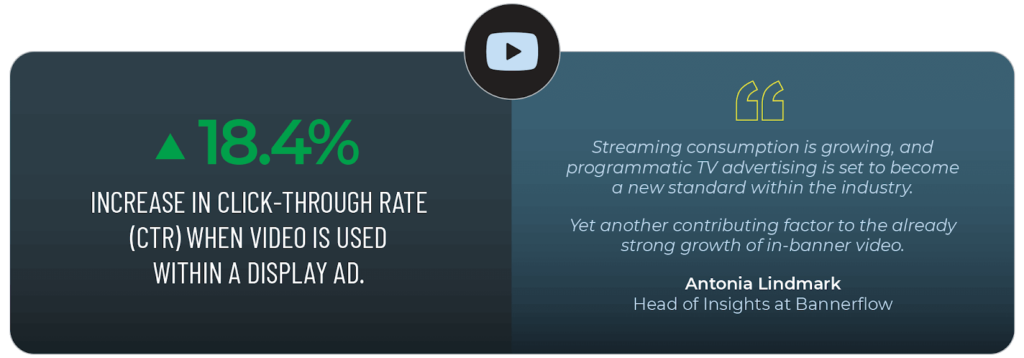
11. Participation in affiliate programs
Affiliate programs help partner with different companies that share the same audience. By showcasing the ads on the site of the affiliate publisher, it is pretty easy to fight banner blindness.
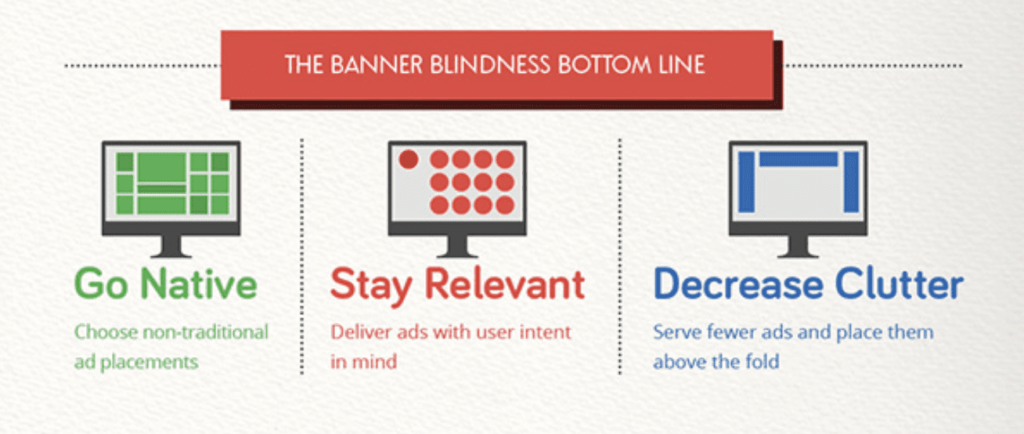
Key Takeaways
- In addition to banner blindness, the user has developed a kind of “tunnel vision” – the areas just mentioned receive significantly less attention than other positions.
- Content should be placed in the center of the page whenever possible.
- Another method of avoiding banner blindness and placing advertising cleverly is so-called native advertising. The advertising is so cleverly integrated into the context of the website that it is hardly perceived as such.
- Some studies show that up to 86 percent of readers don’t even focus on banner ads. To combat banner blindness, advertisers have used creative tricks to make banner ads look like computer system messages.

Conclusion
Banner blindness is an essential phenomenon in user behavior that advertisers must consider when planning media campaigns on the Internet. In recent years, the classic advertising formats in the form of banners have therefore developed into other unique forms such as layer ads or in-text advertising as well as tooltips.
The aim is always to get the most significant possible attention from the user. However, the banner as a form of advertising is becoming more and more difficult. On the one hand, ad blockers are being used more and more by Internet users. But, on the other hand, banners have lost their reliability due to manipulative techniques like cookie dropping.
To conclude, while banner blindness seems like a menace for advertisers, there are some workaround methods to combat it. Often users tend to skip the ads find them annoying and irksome. But, following the tips and techniques mentioned above can fight banner blindness and increase the customer base through digital ads.
Remember that the constant ads cause banner blindness in the first place. So, it would be advisable to put some best practices mentioned above to strike the right balance between the ads and user experience.
FAQs
Banner blindness is part of web-user behavior and describes the tendency of website visitors to ignore page elements that they perceive to be ads.
Dynamic ads are banners that change to adapt to content and promotions specific to the user.
1. Try to ensure your ad doesn’t look typical
2. Test its effectiveness using A/B testing
3. Use videos or dynamic ads
Latest Blogs
Explore how Google’s 2025 AI search updates triggered ranking chaos. Learn actionable strategies to adapt your SEO for AI Overviews, zero-click searches, and SERP volatility. Stay ahead now.
Learn how to rank on AI search engines like ChatGPT, Perplexity, and Gemini by optimizing your content for authority, structure, and relevance. Stay ahead in AI-driven search with this strategic guide.
Explore the best healthcare SEO services for your medical practice. Improve online visibility and effectively reach more patients in need of your services.
Get your hands on the latest news!
Similar Posts

Design
7 mins read
15 Best Firms Offering Design Services in India

Design
5 mins read
All You Need to Know About Data-Driven Design

Design
6 mins read